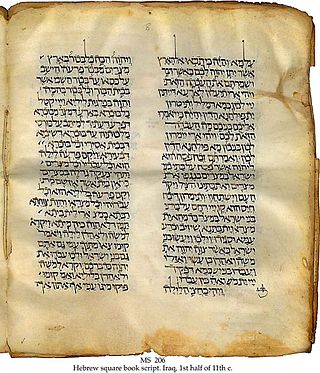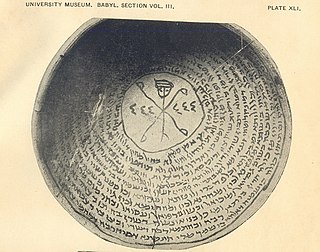Aramaic is a Northwest Semitic language that originated in the ancient region of Syria, and quickly spread to Mesopotamia and eastern Anatolia where it has been continually written and spoken, in different varieties, for over three thousand years. Aramaic served as a language of public life and administration of ancient kingdoms and empires, and also as a language of divine worship and religious study. Several modern varieties, the Neo-Aramaic languages, are still spoken by Assyrians, and some Mandeans and Mizrahi Jews.

A targum was an originally spoken translation of the Hebrew Bible that a professional translator would give in the common language of the listeners when that was not Hebrew. This had become necessary near the end of the first century BC, as the common language was Aramaic and Hebrew was used for little more than schooling and worship. The translator frequently expanded his translation with paraphrases, explanations and examples, so it became a kind of sermon.

The Samaritan Torah, also called the Samaritan Pentateuch, is a text of the Torah written in the Samaritan script and used as sacred scripture by the Samaritans. It dates back to one of the ancient versions of the Hebrew Bible that existed during the Second Temple period, and constitutes the entire biblical canon in Samaritanism.

Targum Onkelos is the primary Jewish Aramaic targum ("translation") of the Torah, accepted as an authoritative translated text of the Five Books of Moses and thought to have been written in the early second century CE.

Jewish languages are the various languages and dialects that developed in Jewish communities in the diaspora. The original Jewish language is Hebrew, supplanted as the primary vernacular by Aramaic following the Babylonian exile. Jewish languages feature a syncretism of Hebrew and Judeo-Aramaic with the languages of the local non-Jewish population.

Judeo-Arabic dialects are ethnolects formerly spoken by Jews throughout the Arabic-speaking world. Under the ISO 639 international standard for language codes, Judeo-Arabic is classified as a macrolanguage under the code jrb, encompassing four languages: Judeo-Moroccan Arabic (aju), Judeo-Yemeni Arabic (jye), Judeo-Iraqi Arabic (yhd), and Judeo-Tripolitanian Arabic (yud).
Biblical Aramaic is the form of Aramaic that is used in the books of Daniel and Ezra in the Hebrew Bible. It should not be confused with the Targums – Aramaic paraphrases, explanations and expansions of the Hebrew scriptures.
There exists a consensus among scholars that the language of Jesus and his disciples was Aramaic. Aramaic was the common language of Judea in the first century AD. The villages of Nazareth and Capernaum in Galilee, where Jesus spent most of his time, were Aramaic-speaking communities. Jesus likely spoke a Galilean variant of the language, distinguishable from that of Jerusalem. Based on the symbolic renaming or nicknaming of some of his apostles it is also likely that either Jesus or at least one of his apostles knew enough Koine Greek to converse with those not native to Judea. It is reasonable to assume that Jesus was well versed in Hebrew for religious purposes.
The Jewish Neo-Aramaic dialect of Zakho is a dialect of Northeastern Neo-Aramaic originally spoken by Jews in Zakho, Iraq. Following the exodus of Jews from the Muslim lands, most speakers now live in Israel, principally Jerusalem and surrounding villages.
The Jewish Neo-Aramaic dialect of Urmia, a dialect of Northeastern Neo-Aramaic, was originally spoken by Jews in Urmia and surrounding areas of Iranian Azerbaijan from Salmas to Solduz and into what is now Yüksekova, Hakkâri and Başkale, Van Province in eastern Turkey. Most speakers now live in Israel.
Inter-Zab Jewish Neo-Aramaic, or Lishanid Noshan, is a modern Jewish-Aramaic dialect, a variant of Northeastern Neo-Aramaic. It was originally spoken in Kurdistan Region of Iraq, in and around Arbil between the Great Zab and Little Zab rivers. Most speakers now live in Israel.
Trans-Zab Jewish Neo-Aramaic, also known as Hulaulá, is a grouping of related dialects of Northeastern Neo-Aramaic originally spoken by Jews in Iranian Kurdistan and easternmost Iraqi Kurdistan. Most speakers now live in Israel.
Barzani Jewish Neo-Aramaic is a modern Jewish Aramaic language, often called Neo-Aramaic or Judeo-Aramaic. It was originally spoken in three villages near Aqrah in Iraqi Kurdistan. The native name of the language is Lishanid Janan, which means 'our language', and is similar to names used by other Jewish Neo-Aramaic dialects .

Judaeo-Aramaic languages represent a group of Hebrew-influenced Aramaic and Neo-Aramaic languages.
Targum is used by the Jews of northern Iraq and Kurdistan to refer to a variety of Aramaic dialects spoken by them till recent times. For details of these dialects, see Judeo-Aramaic language. The word "targum" simply means "translation" in Hebrew, and the primary reference of the term is the Aramaic Bible translations of that name. The Jewish use of "Targum" to mean the Aramaic language in general dates back to the early Middle Ages. An analogy is the use of "Ladino" to mean Judeo-Spanish, and of sharħ to mean Judeo-Arabic.
Samaritan Aramaic, or Samaritan, was the dialect of Aramaic used by the Samaritans in their sacred and scholarly literature. This should not be confused with the Samaritan Hebrew language of the Scriptures. Samaritan Aramaic ceased to be a spoken language some time between the 10th and the 12th centuries, with Samaritans switching to Palestinian Arabic as their vernacular language.
Baghdad Jewish Arabic or autonymhaki mal yihud or el-haki malna is the Arabic dialect spoken by the Jews of Baghdad and other towns of Southern Iraq. This dialect differs from the dialect spoken by the Jews in Northern Iraq, such as Mosul and 'Ana. The Baghdadi and Northern dialects may be regarded as subvarieties of Judeo-Iraqi Arabic. As with most Judeo-Arabic communities, there are likely to be few, if any, speakers of the Judeo-Iraqi Arabic dialects who still reside within Iraq. Rather these dialects have been maintained or are facing critical endangerment within respective Judeo-Iraqi diasporas, namely those of Israel and the United States. In 2014, the film Farewell Baghdad, which is performed mostly in Jewish Baghdadi Arabic dialect, became the first film to be almost completely performed in Judeo-Iraqi Arabic.

Jewish Babylonian Aramaic was the form of Middle Aramaic employed by writers in Lower Mesopotamia between the fourth and eleventh centuries. It is most commonly identified with the language of the Babylonian Talmud, the Targum Onqelos, and of post-Talmudic (Gaonic) literature, which are the most important cultural products of Babylonian Jews. The most important epigraphic sources for the dialect are the hundreds of inscriptions on incantation bowls.
Old Aramaic refers to the earliest stage of the Aramaic language, known from the Aramaic inscriptions discovered since the 19th century.

Shlomo Morag, also spelled Shelomo Morag, was an Israeli professor at the department of Hebrew Language at the Hebrew University of Jerusalem. Morag founded the Jewish Oral Traditions Research Center at the Hebrew University and served as the head of Ben Zvi Institute for the study of Jewish communities in the East for several years. He was a member of the Academy of the Hebrew Language and the Israel Academy of Sciences and Humanities, and a fellow of the American Academy of Jewish Research.







